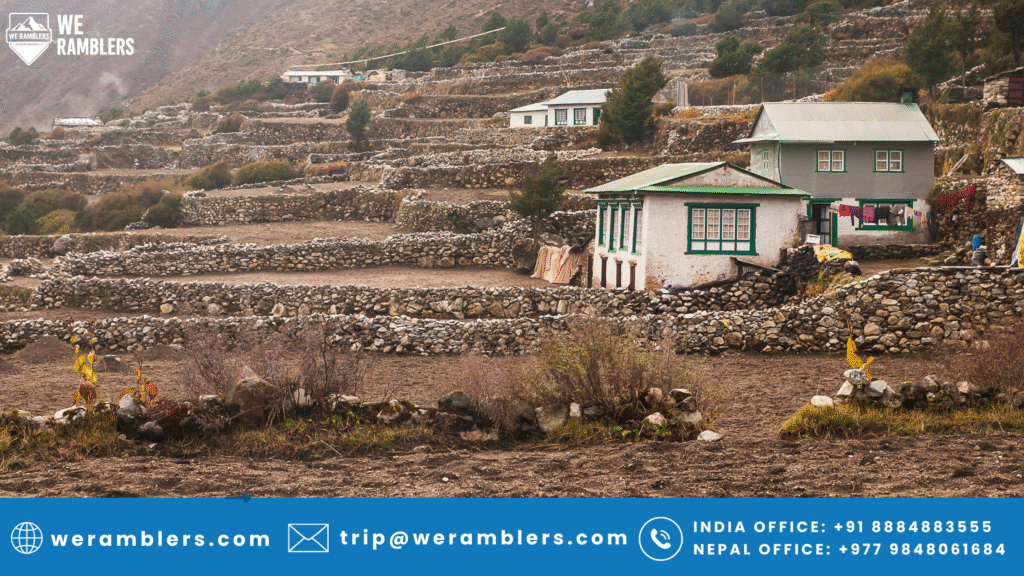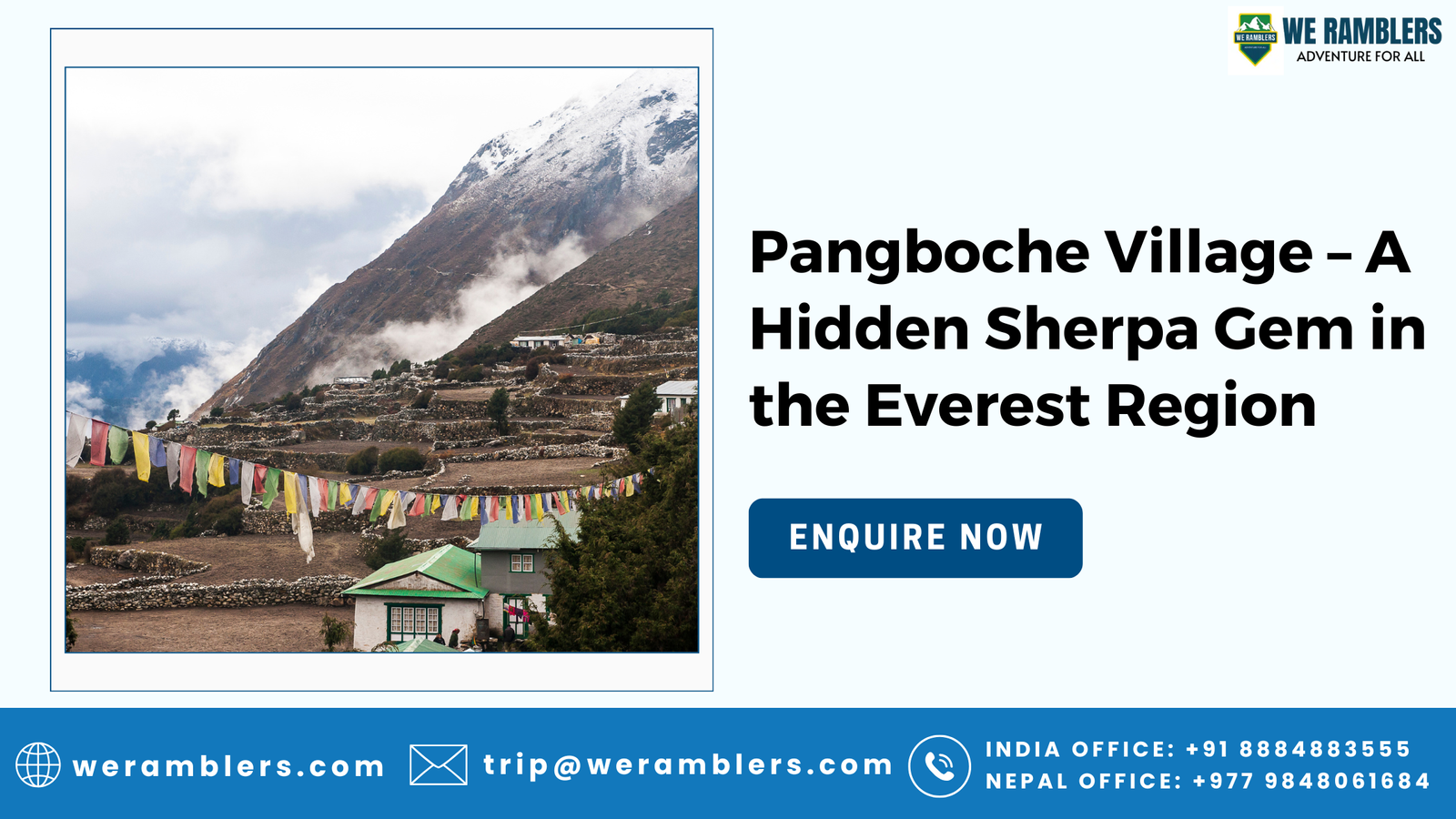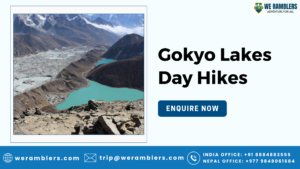Pangboche Village – A Hidden Sherpa Gem in the Everest Region
Pangboche Village is one of the most captivating settlements in the Everest region of Nepal, offering a perfect blend of cultural richness, natural beauty, and Himalayan adventure. Located at an altitude of 3,985 meters (13,074 ft) in the Khumbu region, this Sherpa village is a must-visit stop for trekkers on the Everest Base Camp trek.
Surrounded by the towering peaks of Ama Dablam, Mount Everest, and Lhotse, Pangboche is more than just a trekking stop; it’s a living museum of Sherpa heritage and Buddhist traditions. Its strategic location on the Himalayan trekking route makes it a favored place for rest, acclimatization, and cultural exploration.
Geographical Location of The Pangboche Village & Accessibility
Situated in the Solukhumbu District of northeastern Nepal, Pangboche Village lies within the heart of the Khumbu Valley. It is located between Tengboche Monastery and Dingboche Village, making it an important overnight halt for trekkers.
The most common route to reach Pangboche starts from Lukla, passing through Phakding, Namche Bazaar, and Tengboche before arriving in the village. The journey takes about 4–5 days of trekking, depending on acclimatization schedules.
Pangboche’s position along the Everest trekking trail makes it easily accessible for those heading toward Everest Base Camp, Ama Dablam Base Camp, or the Three Passes Trek. Along the way, trekkers enjoy panoramic views, rhododendron forests, and glimpses of traditional Sherpa culture.
Historical & Cultural Significance
Pangboche holds immense cultural importance in the Everest region. It is home to the Pangboche Monastery, one of the oldest monasteries in the Khumbu, believed to have been founded in the 17th century by Lama Sanga Dorje.
The monastery plays a central role in the spiritual lives of the Sherpa people. Monks conduct Buddhist rituals, bless climbers before expeditions, and host annual festivals like Mani Rimdu, which attract visitors from all over Nepal.
According to legend, Lama Sanga Dorje left handprints and footprints embedded in nearby rock, which are preserved as sacred relics. The monastery also historically housed the mysterious Yeti scalp and hand, which has intrigued adventurers for decades.
For trekkers, visiting Pangboche is an opportunity to experience authentic Sherpa traditions, learn about Tibetan Buddhist culture, and witness how spirituality is deeply woven into daily life in the Himalayas.
Major Attractions in Pangboche Village
- Pangboche Monastery – The spiritual centerpiece of the village and one of the region’s most important cultural landmarks.
- Ama Dablam Base Camp Side Trek – A scenic trail leading from Pangboche to the base camp of one of the world’s most beautiful mountains.
- Breathtaking Himalayan Views – On clear days, you can enjoy stunning panoramas of Mount Everest, Lhotse, Ama Dablam, and Kangtega.
- Traditional Sherpa Houses – The architecture reflects centuries-old Himalayan building techniques, often adorned with colorful prayer flags.
- Local Tea Houses & Lodges – Offering warm hospitality, hearty meals, and cozy rooms for trekkers.
The village is also a prime photography location, with Himalayan viewpoints in every direction and a peaceful atmosphere away from the larger trekking hubs.

Trekking Routes Passing Through Pangboche Village
Pangboche Village is part of several iconic trekking routes in the Everest region:
- Everest Base Camp Trek – The most popular trekking route in Nepal, passing directly through Pangboche on the way to Gorak Shep and Kala Patthar.
- Ama Dablam Base Camp Trek – A shorter yet spectacular trek from Pangboche to the foot of Ama Dablam.
- Three Passes Trek – An adventurous circuit crossing Kongma La, Cho La, and Renjo La, with Pangboche as an important resting point.
To trek in the region, travelers must obtain the Sagarmatha National Park Permit and the Khumbu Pasang Lhamu Rural Municipality Permit. Both are essential for legal trekking in the area and contribute to conservation efforts.
Accommodation & Food in Pangboche
Trekkers can expect a range of tea houses and lodges in Pangboche, offering basic yet comfortable accommodation. Rooms typically include twin beds with warm blankets, and shared bathrooms are common.
Dining options include traditional Sherpa dishes like dal bhat, sherpa stew (shyakpa), and tsampa, as well as Western-style meals such as pasta, pancakes, and fried rice. Most lodges also serve hot drinks like tea, coffee, and ginger lemon honey for warmth at high altitude.
Many accommodations provide Wi-Fi (at an extra cost), charging facilities, and dining rooms with stoves to keep guests warm during cold evenings.
Wildlife & Natural Environment in Pangboche Village
Pangboche’s surroundings are rich in Himalayan flora and fauna. Trekkers often pass through rhododendron forests, juniper bushes, and alpine meadows on their way to the village.
The area is part of the Sagarmatha National Park, a UNESCO World Heritage Site, which protects rare species such as the Himalayan tahr, musk deer, snow leopard, and the colorful Himalayan monal — Nepal’s national bird.
This natural environment adds to the trekking experience, offering chances for wildlife spotting and photography.
Best Time to Visit Pangboche Village
The ideal seasons to visit Pangboche Village are:
- Spring (March to May) – Pleasant temperatures, blooming rhododendrons, and excellent mountain visibility.
- Autumn (September to November) – Stable weather, crisp air, and clear skies for panoramic views.
Winter trekking is possible but challenging due to snow and extreme cold, while summer/monsoon months bring heavy rainfall and reduced visibility.
We Ramblers — Your Himalayan Adventure Partner
We Ramblers is a trusted adventure travel company specializing in guided treks and expeditions across Nepal. With a focus on responsible trekking, we work closely with local communities to ensure tourism benefits the people and preserves the environment.
Our team of certified guides and experienced porters provide personalized trekking experiences on routes like the Everest Base Camp Trek, Annapurna Circuit, Manaslu Circuit, Langtang Valley Trek, and more. We are committed to sustainable tourism, offering itineraries that blend adventure, cultural immersion, and environmental stewardship.
Frequently Asked Questions (FAQs) About Pangboche Village
1. Where is Pangboche Village located?
Pangboche Village is in the Khumbu region of Nepal, along the Everest Base Camp trekking route, between Tengboche and Dingboche.
2. How high is Pangboche Village?
Pangboche is situated at an altitude of 3,985 meters (13,074 ft) above sea level.
3. What is Pangboche famous for?
It is famous for the Pangboche Monastery, stunning views of Ama Dablam and Mount Everest, and its rich Sherpa cultural heritage.
4. How do I reach Pangboche Village?
The most common route is to fly to Lukla and trek through Phakding, Namche Bazaar, and Tengboche before reaching Pangboche.
5. Is Pangboche on the way to Everest Base Camp?
Yes, it lies directly on the trail to Everest Base Camp, making it a popular overnight stop for trekkers. Contact us now for more details.





